As an Amazon Associate I earn from qualifying purchases.
You’ll love these five wooden kitchen picks for 2025: the space‑saving Amazon Basics Kids’ Corner playset, Tidlo’s Wooden Fruit Salad and Cutting Vegetables sets, TP Toys’ outdoor mud kitchen, and Le Toy Van’s Honeybake toaster. They’re made from FSC‑sourced hardwoods, use non‑toxic finishes, and stand up to energetic play. They boost fine motor skills and long‑lasting pretend play. Keep scrolling for full specs, safety notes, and buying tips.
Key Takeaways
- Amazon Basics Kids’ Corner Wooden Kitchen Playset — space-saving, FSC-certified, interactive knobs, lights, and realistic setup for ages 3+.
- Tidlo Wooden Fruit Salad Play Food — responsibly sourced wood, colorful pieces and crate encourage imaginative healthy-eating role play.
- Tidlo Wooden Cutting Vegetables Set — durable, knife-and-veg pieces with realistic cutting sounds to build fine motor and coordination skills.
- TP Toys Early Fun Mud Kitchen — weather-resistant FSC timber, stainless-steel sink and removable basin for easy-clean outdoor messy play.
- Le Toy Van Honeybake Wooden Toaster — sustainable rubberwood, spring-loaded pop-up toast and Velcro butter to practice turn-taking and fine motor control.
Amazon Basics Kids’ Corner Wooden Kitchen Playset (Espresso/Grey)
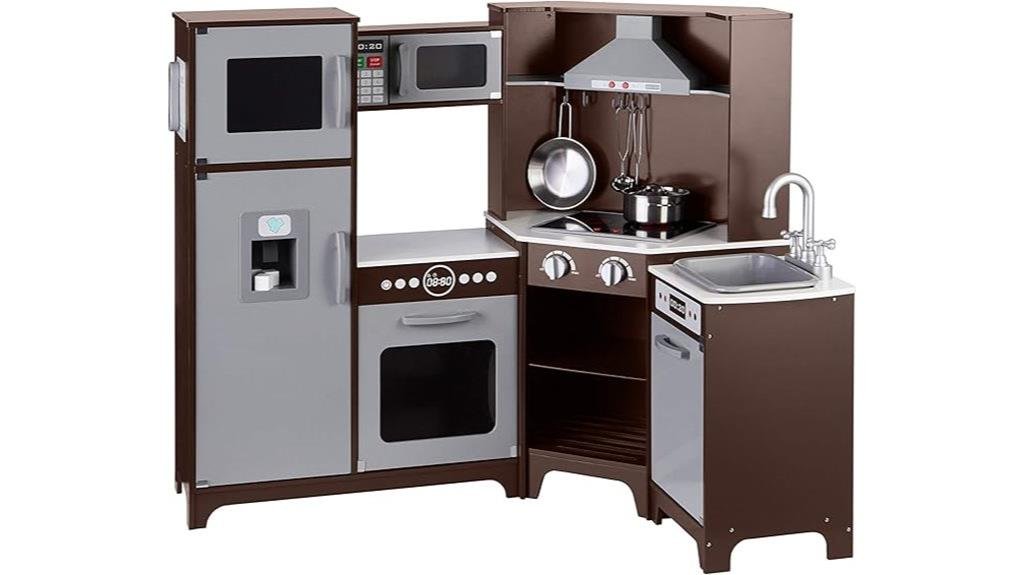
If you want a space-saving, realistic play kitchen that stands up to regular use, the Amazon Basics Kids’ Corner Wooden Kitchen (Espresso/Grey) is a smart choice. You’ll get a fully equipped corner play kitchen (99 x 71 x 89 cm) made from wood and child-safe, FSC-certified materials in espresso/grey. Interactive doors, turn-and-click knobs, lights and sounds (batteries required), plus spatula, ladle, pot with lid and skillet, encourage imaginative play and spatial awareness. Assembly takes about four hours with ~80 screws and 24 panels; tether to a wall. It weighs 20.41 kg, earns 4.3/5 average, includes Amazon support and returns.
Best For: Families with young children who want a realistic, space‑saving, durable play kitchen that encourages imaginative and spatial play.
Pros:
- Corner design saves floor space while offering a fully equipped, realistic kitchen setup.
- Made from wood with FSC certification and sturdy construction for regular use.
- Interactive lights, sounds, turn/click knobs and included cookware boost imaginative play.
Cons:
- Assembly is time-consuming (≈4 hours) with ~80 screws and 24 panels.
- Some parts may feel cheap or lower quality despite overall satisfactory build.
- Lights and sounds require batteries, and the unit should be tethered to a wall for safety.
Tidlo Wooden Fruit Salad – Play Food Set, 6 H x 12 W x 15 D cm
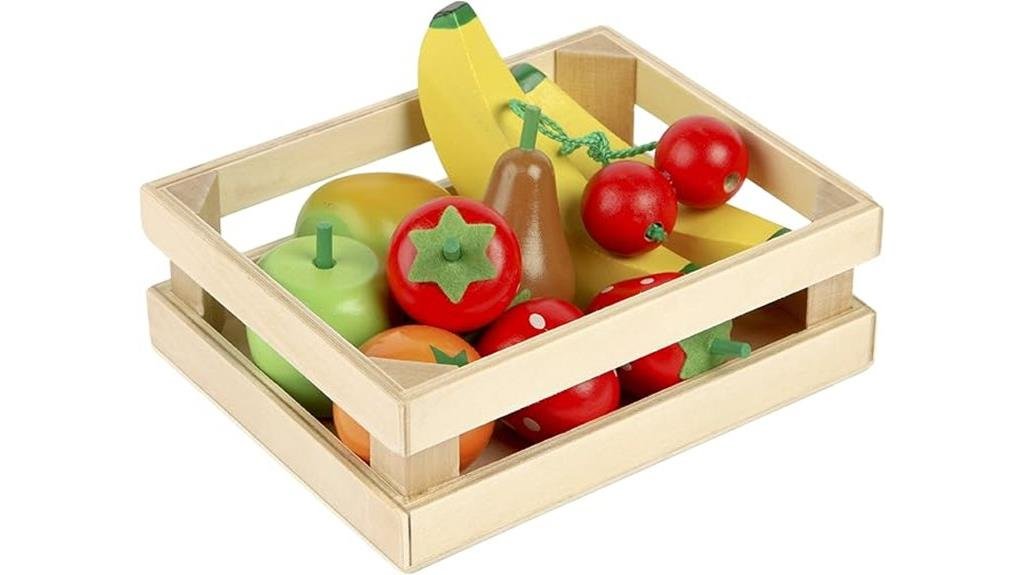
You’re buying for little ones who need a durable, eco-friendly play set—Tidlo’s Wooden Fruit Salad fits that role with responsibly sourced wood, a storage crate, and colorful pieces that build dexterity and imaginative play. The 6 x 12 x 15 cm set weighs 330 g and suits ages 36 months to 12 years; no assembly or batteries are required. It includes pears, apples, strawberries and other multicoloured fruits that encourage role play and healthy-eating pretend games. Reviewers give it 4.4/5 from 292 ratings praising quality and durability, though some note smaller size and occasional paint flaws. 30-day returns apply.
Best For: Parents and caregivers seeking a durable, eco-friendly wooden play food set that promotes dexterity and imaginative role play for toddlers and young children.
Pros:
- High-quality, durable construction from responsibly sourced wood that withstands toddler play.
- Includes a wooden storage crate and colourful fruit pieces that encourage role play and fine-motor skills.
- No assembly or batteries required; suitable for ages 36 months–12 years.
Cons:
- Several buyers find the pieces smaller than expected for the price.
- Occasional paint-quality issues reported (chipping or uneven finish).
- Relatively simple assortment that may not engage older children long-term.
Tidlo Wooden Cutting Vegetables Set, 32 x 18 x 8 cm
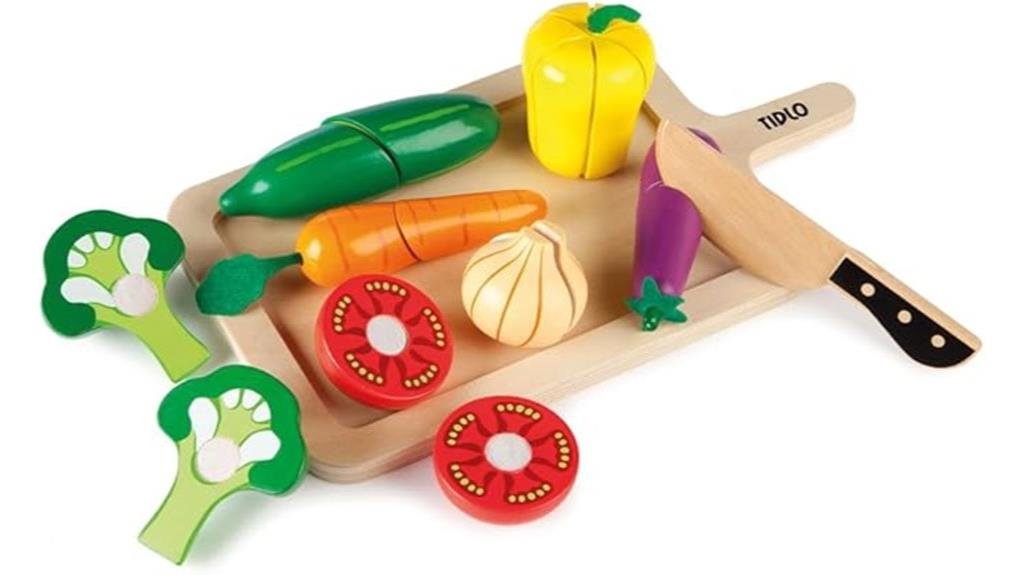
Parents and preschool teachers will find the Tidlo Wooden Cutting Vegetables Set ideal for 3–12-year-olds who need a durable, hands-on toy that builds spatial awareness and fine motor skills. You get a 32 x 18 x 8 cm wooden set with multicoloured vegetables, velcro joins, a tray and a knife; assembly and batteries aren’t required. The 650 g, responsibly sourced, very durable pieces withstand heavy play and make realistic cutting sounds to boost imaginative kitchen role-play and dexterity. With a 4.7-star average from 481 ratings, this model (T-0215, ASIN B00CISHEYW) offers longevity and easy storage compared with plastic alternatives.
Best For: Parents and preschool teachers seeking a durable, hands-on wooden play set that builds spatial awareness and fine motor skills in children aged 3–12 years.
Pros:
- Durable, well-crafted wooden pieces with strong velcro that withstand heavy play.
- Encourages imaginative kitchen role-play and improves dexterity and spatial awareness.
- No assembly or batteries required; compact 32 x 18 x 8 cm size makes storage easy.
Cons:
- Not suitable for children under 36 months due to small parts.
- Wooden pieces can be harder to clean than plastic alternatives.
- May be outgrown by older children or feel limited for larger/group play due to set size and variety.
TP Toys Early Fun Mud Kitchen Playhouse Accessory, Wooden
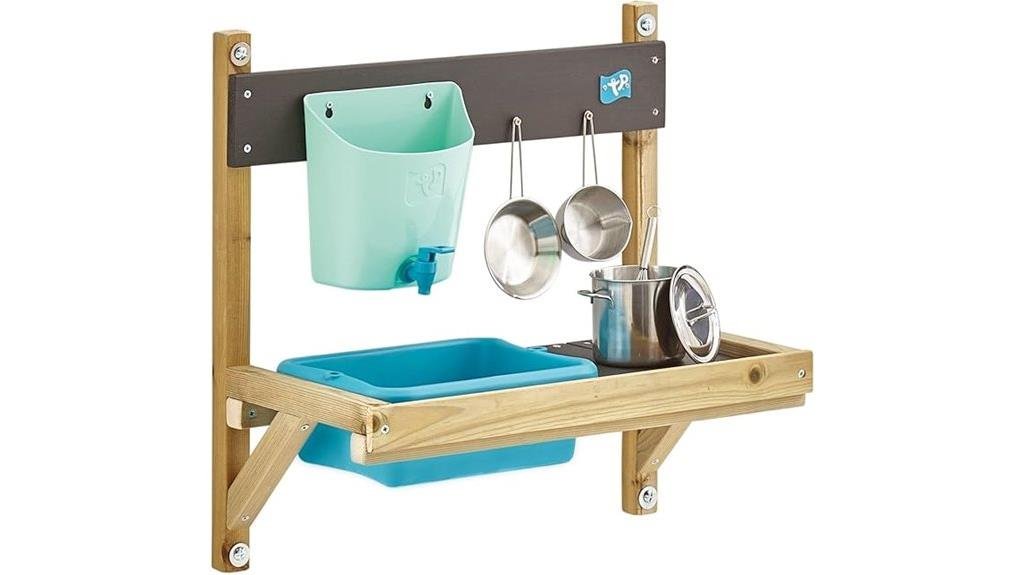
Families looking for a weather-resistant outdoor mud kitchen that stands up to rough play and is easy to clean will find the TP Toys Early Fun Mud Kitchen ideal: it’s made from FSC-certified timber, features a stainless-steel sink with a removable basin, and provides shelves and hooks for utensils—perfect for 3–12‑year‑olds who love hands-on imaginative play. You’ll appreciate its durable, weatherproof build and compact footprint (31×55×56cm, 3.7kg). Reviewers praise sturdiness and engagement, though some report tricky assembly and weak screws. It’s a solid, imaginative gift for ages 3+, backed by a 30-day return and no batteries needed, support available.
Best For: families looking for a weather-resistant, compact outdoor playset that encourages imaginative messy play for children aged 3–12.
Pros:
- Durable, weather-resistant FSC timber with a stainless-steel sink and removable basin for easy cleaning.
- Encourages open-ended, cooperative play with a hob, shelves and hooks for utensils.
- Compact footprint (31×55×56 cm), lightweight (3.7 kg) and generally praised for sturdiness.
Cons:
- Some users report tricky assembly due to unclear instructions and pre-drilled holes.
- Included screws/hardware can be weak; many recommend replacing with stronger fasteners.
- No basin cover or certain accessories (customers suggested adding a cover and improved fittings).
Le Toy Van Honeybake Wooden Toaster Breakfast Play Set
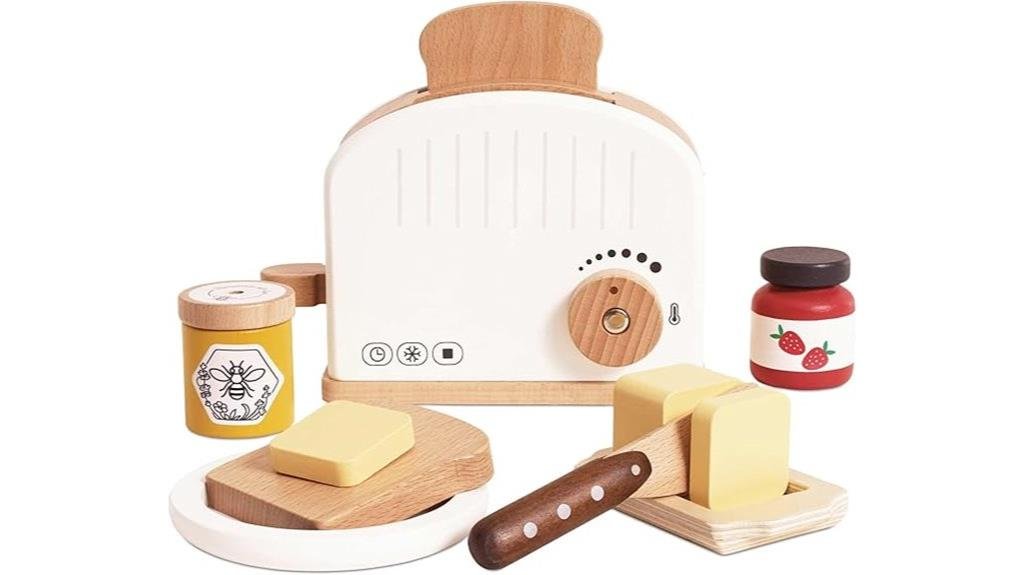
If you want a sustainable, sturdy toaster with a spring-loaded pop-up feature that builds turn-taking and fine-motor skills, the Le Toy Van Honeybake set is perfect for kids aged 3–8 — and you’ll appreciate it’s made from durable rubberwood finished with non-toxic paints for realistic, long-lasting pretend play. The set includes two slices of toast, butter pat with Velcro, jam pot, knife and plate, and needs no assembly or batteries. It encourages social interaction, concentration, hand-eye coordination and storytelling, complements other Honeybake pieces, and averages 4.3 out of 5 from 600 reviews; Amazon provides a 30-day return. Model TV287.
Best For: parents and caregivers looking for a sustainable, sturdy wooden pretend toaster that builds fine-motor, turn-taking and imaginative play skills in children aged 3–8.
Pros:
- Durable, sustainable rubberwood construction with non-toxic paints — safe and eco-friendly.
- Spring-loaded pop-up toaster and Velcro butter provide realistic, hands-on play that develops fine-motor and social skills.
- No assembly or batteries required; integrates well with other Le Toy Van Honeybake kitchen pieces for extended play.
Cons:
- Some reviewers reported minor issues with the jam jar and the toaster’s button mechanism.
- Non-electronic design offers no sounds or lights for additional sensory realism.
- Not suitable for children under 3 (recommended 36 months+), and may be less engaging for older kids seeking more complex toys.
Factors to Consider When Choosing Wooden Kitchen Toys
When choosing wooden kitchen toys, you’ll want to contemplate age appropriateness and educational value so play matches your child’s development. Check material quality and safety standards—look for solid wood, smooth finishes, and non-toxic paints that meet current regulations. Also think about size and storage so the set fits your space and it’s easy to put away.
Age Appropriateness
Because children develop at different rates, check manufacturer-recommended age ranges—usually 36 months to 12 years—and match a toy to the skills you’ll want them to build. Choose toys that target dexterity, spatial awareness and imaginative play appropriate to each stage: simple, chunky pieces for toddlers encourage grasping and role-play, while complex sets with interactive elements challenge older kids’ coordination and creativity. Watch for small parts and choking hazards on younger sets, and prefer lightweight pieces they can handle easily. For older children pick larger, more detailed kits that support intricate role play and withstand rougher play. Matching complexity and size to your child’s abilities keeps play safe, engaging and developmentally useful. Rotate options as skills evolve so you keep challenges fresh and learning consistently progressive.
Material Quality
Although a toy’s paint and details catch your eye, prioritize the wood’s quality and finish: choose pieces made from responsibly sourced hardwoods (look for FSC certification) and coated with non‑toxic, child‑safe paints or oils. Check weight and sturdiness: heavier, solid pieces resist rough play and avoid breakage. Inspect joinery and edges — tight joints and smooth finishes mean less chipping and splintering over time. Read customer reviews to see how toys hold up; look for consistent reports about paint wear, dents, or wobbling. Choose hardwoods like beech or maple, since they stand up to repeated handling better than softwoods. Finally, consider surface treatments that penetrate the wood rather than sit on top; they tend to wear more gracefully and extend the toy’s usable life.
Safety Standards
If you want peace of mind, check that you’re choosing wooden kitchen toys made from responsibly sourced hardwood and finished with non‑toxic paints or oils, and that they carry certifications like FSC. Also confirm the manufacturer states compliance with applicable toy-safety regulations in your region — standards can differ, so look for EN71 (Europe), ASTM F963 (US), or similar marks. Inspect product descriptions and labels to verify toys are free from lead, phthalates and other harmful chemicals. For toddlers, avoid items with detachable small parts or long strings; age recommendations and warnings should be clear. When in doubt, request test reports or supplier documentation. Choosing certified, clearly labeled toys reduces health and choking risks for little chefs. You’ll know you’ve made a safer choice today.
Educational Value
When you choose wooden kitchen toys, focus on pieces that develop fine motor skills and spatial awareness while encouraging imaginative role-play, social interaction and language growth. Pick sets with knobs, latches and pretend utensils so you and your child can practice dexterity, hand-eye coordination and basic problem-solving. Choose realistic play food to normalize fruits and vegetables and promote positive attitudes about healthy eating. Look for toys that invite role-playing scenes—those deepen vocabulary, turn-taking and empathy as children act out routines. Prioritize responsibly sourced, well-made wood: durability and safe finishes mean longer, safer learning through repeated use. When educational value is central, toys become tools for cognitive, social and motor development rather than just entertainment. You’ll notice sustained curiosity and skill growth over time daily.
Size and Storage
Because space is often at a premium, check the playset’s dimensions so it fits your area and leaves room for play. Measure the intended spot and compare dimensions—sets range from compact counters to full-size kitchens. Consider weight: lighter sets are easier for your child to move and rearrange, while heavier ones stay put during energetic play. Favor designs that simplify storage, like built-in compartments or models that disassemble for compact shelving. Note age recommendations, since toddler-friendly sets tend to be smaller and simpler, while older-kid models can be larger and more complex. Finally, review assembly requirements; some larger playsets involve many parts and can take hours to set up, affecting when play can start. You’ll want storage that your child can reach and use.
Accessories and Compatibility
After sizing up dimensions and storage, you’ll want to check which accessories the kitchen includes and whether they mesh with toys your child already owns. Look for sets that include utensils, pots, pans and a variety of play food—fruits, vegetables and baked goods—to boost imaginative cooking and teach healthy-eating concepts. Confirm compatibility so pieces fit or stack with other wooden sets you have, creating cohesive scenes. Inspect materials: choose high-quality wood and non-toxic finishes so accessories stay safe and durable through rough play. Also evaluate interactive features like realistic sounds, knobs that turn and movable parts to deepen role play without compromising sturdiness. Prioritize sets that balance variety, safety and interoperability for long-term value. You’ll also consider price, storage, and ease of cleaning regularly.




